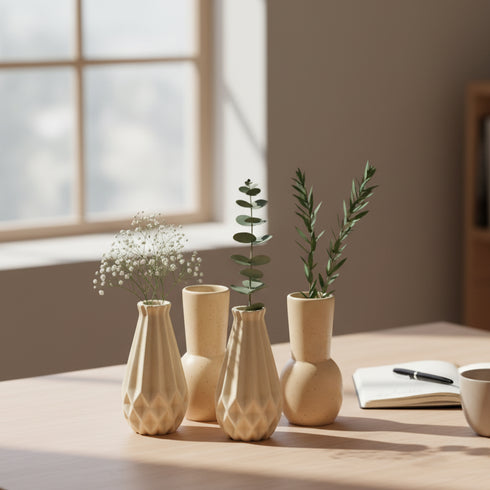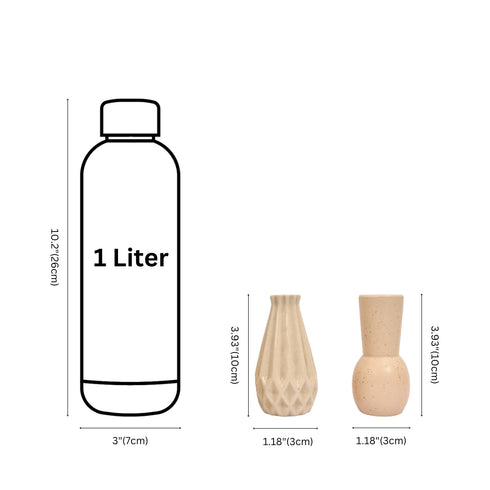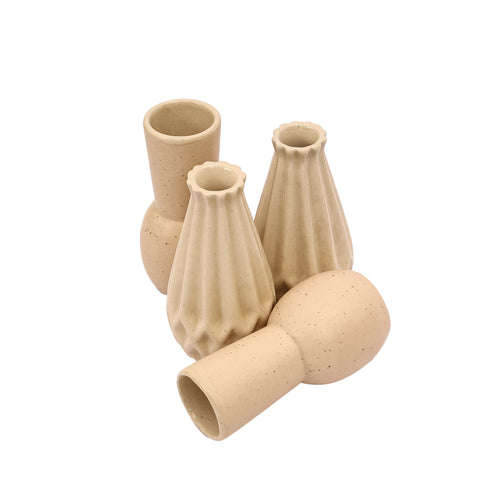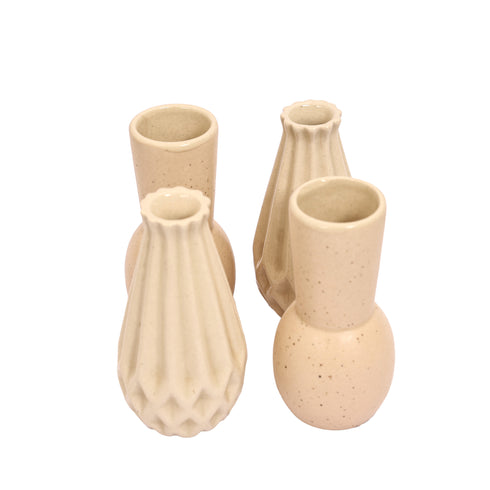Out of Stock
Abstract designed ceramic mini bud vase set (Set of 4)
₹829
₹579
Save 31%
Enhance your living room with this abstract-designed mini bud vase set. It has been handcrafted by local artisans with intricate detailing. This minimalist vase seamlessly blends artistry and simplicity. It will augment the look of your home or office with its unique finish and rustic charm. It is ideal for shelves or tabletops. It can be used for flower arrangement, aroma therapy, and wedding or event décor.
Buying for a group or event?
Make a bulk enquiry

 Product Details
Product Details
- SKU Code: HD_CR_01832_MC
- Art Type : Pottery
- Product : Bud vase
- Material : Clay
- Dimensions : length – 9cm, width – 13cm, Height – 9cm
- Design : Abstract Design
- Color : White
- Default Title Weight: 500 gms
- Category : Home décor
- Sub-category : Decorative vases
- Packaging Content : Abstract designed ceramic mini bud vase X 4
- Country of Origin : India
 Features
Features
- Artistic Craftsmanship – This vase has been intricately handcrafted by skilled artists of Khurja, ensuring that every piece is unique. It showcases the talent and dedication of indigenous artisans.
- Sustainable Material – Made from eco-friendly and abundant clay, this bud vase requires minimal energy for processing and is fully biodegradable.
- Versatile Use – Perfect for flower arrangements and aromatherapy, it can be placed on shelves, dining tables, or desks. Its compact size makes it ideal for any room or office, and it also serves as a thoughtful and elegant gift.
- Minimalistic Design – With its clean and lean silhouette, this vase highlights the beauty of single-stem flowers and adds a touch of elegance to your home décor.
 Preserving Timeless Traditions of Craftsmanship
Preserving Timeless Traditions of Craftsmanship
Khurja Pottery is a traditional art from the district of Bulandshahr in UP. As per legend, King Taimur of Afghanistan brought Syrian and Egyptian potters around 500 years ago and settled in the Khurja region. Khurja pottery is a renowned art secured under the Geographical Indications and ranks 178 in India's GI Act, 1999. Modern-day Khurja pottery flourished in the 1940s till partition. However, this art was revived in 1952 by the pottery development centre, leading to a significant transformation in the spread of this art from foreign countries.
 Manufacturing Process
Manufacturing Process
- Developing Clay – In the beginning, all materials are combined in a ratio not revealed to the public. Then the mixture is ground in a ball mill machine for around 15 hours. Later, when consistency is achieved in the mixture, it is put between pan filters, and only relevant water content is kept within a 0.75-radius clay disc. Clay discs are again processed through a pug mill machine using a pugging method, which helps in obtaining a fine clay mixture. In the pug mill, Archimedes screws force clay in upward and straight movement. Finally, solid and liquid clay are obtained from this process.
- Clay Moulding Process – Moulding is used to develop ceramic jars where POP (Plaster of Paris) is used for settling moulds. It is ensured that there are no lumps in the blended solution. Later, clay results are discharged into the prepared mould until the cavity is filled. To eliminate bubbles, the mould box is rotated so only the needed clay remains inside the mould.
- Smoothing & Painting Process – In the smoothing process, shrivelled products are shaped using a semi-finished method. Then, sandpaper is used for sanding, which enhances the outer surface.
- Glazing Process – Glazing refers to the glossy finish applied to the artifacts. It is used for weatherproofing, decoration, and reinforcing the ceramics. These glazes come in various finishes, including clear and translucent. Flower embossing is then done on the surface to give it an aesthetic look.
- Firing Procedure – Finally, the firing process is done in a covered kiln, traditionally a brick kiln. Nowadays, electric kilns are used, which offer temperature control for better convenience and reduced losses.
 Note
Note
- Handle with Care – These ceramic jars should be used with care as they can break easily. Use a soft and damp cloth to clean the jar. Avoid using harsh chemicals, as they might damage the surface.
- Not for Microwave Use – These ceramic jars shouldn’t be used in extreme temperatures or placed in a microwave, as they may break.
- Proper Sealing – These jars should be sealed properly to keep the contents fresh and prevent moisture from entering.














